WHAT'S NEW ACROSS THE WORLD
| What's New ©by
Laif DeMason
The recent blackout experienced in the Northeast
has made all aquarists acutely aware that fish-keeping is totally reliant
on a constant supply of electricity. Since most cichlid hobbyists have
many tanks, what can be done to minimize losses from long-term power interruptions?
First, don’t panic! Most aquaria stocked at normal densities can survive
quite easily for from a few to several hours without electricity. During
such interruptions, the fish may become “spooked” and hide — this is a
good sign. Simply do NOT feed your fish on that day! A bad sign would be
fish hanging at the surface, a sign that the water is low in oxygen. For
a long-term power outage, you can run battery-powered aerators part of
the time. Prepare yourself ahead with bait aerators run on D-cell batteries,
which are inexpensive at sport fishing stores. Buy a least one per two
large tanks. If your system runs off a central blower, you’ll need a car
battery-operated blower from aquaculture supply stores (for under $200.00).
For larger solutions, there are portable generators; select one of at least
5000 KW (but run it OUTSIDE your building). Even if you didn’t lose fish
this time, this blackout serves as a wake-up call — be prepared!
Here’s “what’s new” on the cichlid scene: |
Lake Tanganyika
The usual supply lines are still providing cichlids, Zambia and Tanzania
per normal with Burundi exporting in spite of recent rebel attacks in Bujumbura.
Congo is still hit-or-miss with the usual talks about permanent collecting.
Bred fishes are available in good numbers as well.
|
what's new: Lake Tanganyika
|

More blue Cyphotilapia frontosa, — this one
from Nangu, Zambia — are being harvested, along with other fishes in the
area, such as black calvus. |

Altolamprologus cichlids are still quite popular;
A. compressiceps “red” are collected from two places in Tanzania.
Individuals vary in the intensity of red in their body and fins. |
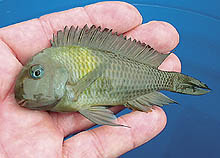
Also from Tanzania, the blue-eyed Tropheus
from near the mouth of the Malagarasi River; some of the “forgotten” Tropheus
of the past are being noticed again. |

Something new on the scene from a specialty breeder
— an albino Julidochromis transcriptus. Photo by R. Bachu. |
Lake Malawi
Supplies are still good from both Malawi and Tanzania, while Mozambique
activity is spotty. Although the volume of exports seems to have slowed,
the number of specialty species has increased from all shippers. Popular
bred items include newer varieties as well as some of the “forgotten” species
from the past.

Caught at depth in northeastern Malawi, a new yellow
Cynotilapia afra can exhibit either bright yellow or orange colors
depending on mood. |

A newly-exported Pseudotropheus perspicax from
Mbowe Island (Malawi) sports a distinct orange cap and dorsal margin. |

Also recently exported is Labidochromis gigas,
a little blue-barred cichlid from Malawi. Photo by A. Konings. |

An interesting multi-colored mbuna sold as Ps.
sp. “yellow belly zebra” is also from Mbowe Island, Malawi. |
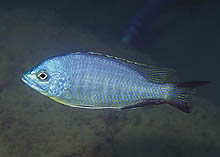
Collected along the southern Tanzanian coast, Copadichromis
sp. “likomae blue” has a metallic sheen. Photo by A. Konings. |
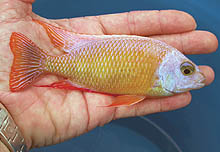
Developed in Florida some time ago, Protomelas
sp. “steveni Taiwan albino” sports electric red, orange, and bluish-white.
Many normal-colored juveniles carrying the albino gene were sold, and thus
albino fry have appeared in broods in other places. |
West Africa
Continued interest in these cichlids has pushed collectors to provide
more varieties from the rivers of Congo (Zaire), Cameroon, and Guinea.
Numerous cichlids are being shipped from species “hot spots”, especially
from Cameroon and Guinea. Unfortunately many varieties are seasonal and
will not be collected again until spring.

A very small species, Nannochromis dimidiatus
has been exported recently from the Congo in good numbers. |

Other river cichlids, such as Lamprologus congoensis,
are currently supplied from Congo. Photo by A. Konings. |

Many different varieties of Pelvicachromis taeniatus
— such as this male “Dehane” — are exported from Cameroon. Photo by A.
Lamboj. |
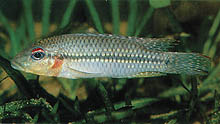
Also from Cameroon (Ntem River), Parananochromis
longirostris can reportedly grow quite large in the aquarium. Photo
by A. Lamboj. |
Neotropics
The collecting season has been very good in Brazil and other South American
countries this year. If you are looking for wild-caught pikes or discus,
they are available now. Many other varieties and species from the Americas
are also being provided by specialty breeders.

Many of the more appealing eartheaters are actively
bred for sale; shown here is Geophagus sp. “Bahia red.” Photo by
J. Rapps. |
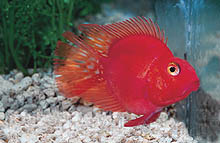
Created in the Far East a couple of years ago, the
“Parrot-fish” cichlid is a hybrid that has been selected for its oddly-shaped
head and now can be bought in several color forms. Courtesy of Jy Lin Trading
Company, Ltd. |
|















